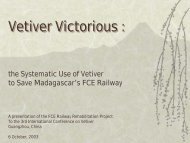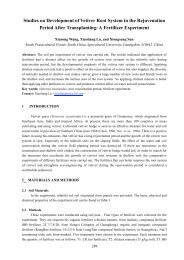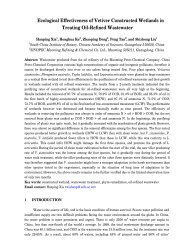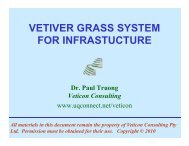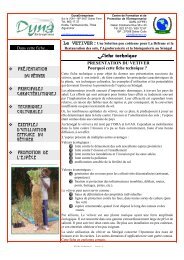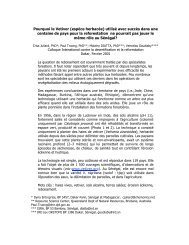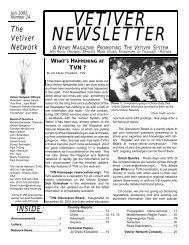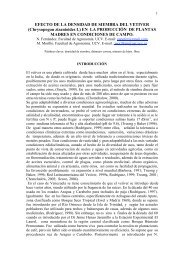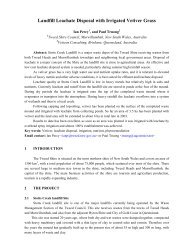Leaf anatomy of a miracle C4 grass: Vetiveria zizanioides L. Nash ...
Leaf anatomy of a miracle C4 grass: Vetiveria zizanioides L. Nash ...
Leaf anatomy of a miracle C4 grass: Vetiveria zizanioides L. Nash ...
You also want an ePaper? Increase the reach of your titles
YUMPU automatically turns print PDFs into web optimized ePapers that Google loves.
<strong>Leaf</strong> <strong>anatomy</strong> <strong>of</strong> a <strong>miracle</strong> <strong>C4</strong> <strong>grass</strong>: <strong>Vetiveria</strong> <strong>zizanioides</strong> L. <strong>Nash</strong>.<br />
M. S. Chaudhry and G. Sarwar<br />
Cholistan Institute <strong>of</strong> Desert Studies, The Islamia University <strong>of</strong><br />
Bahawalpur, Pakistan.<br />
Abstrac<br />
Vetiver <strong>grass</strong> (<strong>Vetiveria</strong> <strong>zizanioides</strong>) is a perennial <strong>C4</strong> <strong>grass</strong> belonging to the family Poaceae<br />
(Gramineae). The leaves <strong>of</strong> <strong>C4</strong> plants are characterized by Kranz-type <strong>anatomy</strong>. The Vetiver<br />
<strong>grass</strong> has many unique morpho-physiological characteristics as compared to other <strong>C4</strong> <strong>grass</strong>es.<br />
Morphologically<br />
this plant has a strong, deep penetrating, aerenchymatous, fast growing root<br />
system while pysiologically this <strong>grass</strong> is both a xerophyte and a hydrophyte, least affected by<br />
drought and floods. It has strong ecological adaptability and is highly tolerant to frost, heat,<br />
extreme acidity, alkalinity and metal toxicity. In possessing these characteristics, vetiver is highly<br />
suitable for treating contaminated and polluted wastewater from industries as well as domestic<br />
discharge. With the development <strong>of</strong> study and utilization, this <strong>grass</strong> is now regarded as a tool for<br />
environmental engineering and one <strong>of</strong> the most versatile crops <strong>of</strong> the millennium.<br />
Keeping in view the deep importance <strong>of</strong> this plant for reclamation <strong>of</strong> polluted environment and its<br />
physiological characteristics we are reporting the leaf <strong>anatomy</strong> <strong>of</strong> vetiver <strong>grass</strong> for the first time<br />
from Pakistan. The aim <strong>of</strong> the present study is to visualize if the leaf <strong>anatomy</strong> helps this plant to<br />
become physiologically unique from other plants used for environmental engineering and to<br />
provide bench mark data on the <strong>anatomy</strong> <strong>of</strong> vetiver leaf so that other researchers may take benefit<br />
for further such studies.<br />
The results <strong>of</strong> present study reveal that there is thick cuticle layer <strong>of</strong> 1.5 to 2µ on the leaves while<br />
the upper epidermis has high stomatal density to that <strong>of</strong> lower epidermis. The distances between<br />
two large longitudinal veins, between large and intermediate longitudinal veins, between large<br />
and central small longitudinal veins, and between two transverse veins has been estimated as
744.32, 310.32, 124.27, 916 micron meter respectively. It is concluded that various anatomical<br />
characteristics such as large air spaces, type <strong>of</strong> stomata, nature <strong>of</strong> epidermis, arrangement <strong>of</strong><br />
epidermal cells and efficient venation system crafts this plant very distinctive from the other <strong>C4</strong><br />
plants. This may be the reason that this plant can survive in various adverse conditions.




